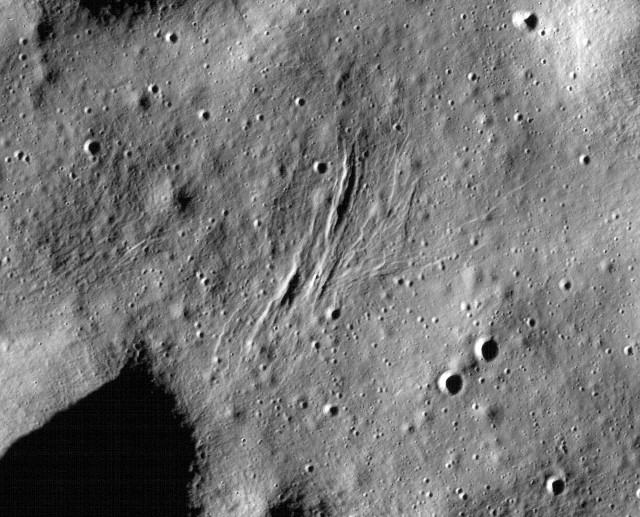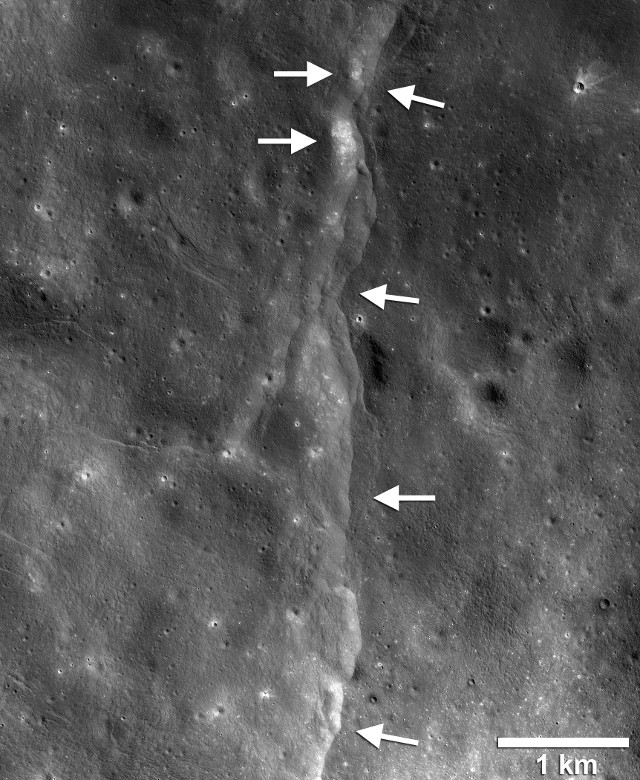
An article published in the journal “Nature Geoscience” offers clues to the fact that the Moon may still be tectonically active. A team of researchers analyzed images captured by NASA’s Lunar Reconnaissance Orbiter (LRO) space probe in 2010 discovering thousands of tectonic faults generated by the Moon’s progressive shrinking as it cooled down. Some researchers have been working on these geological analyzes since those photos were taken but initially they brought clues about a recent activity while the new clues indicate that an activity still exists.
The Moon doesn’t have a plate tectonics like the Earth so the activity that was thought to be a thing of the past takes place following its cooling, which causes its interior to slowly shrink causing cracks on the surface. Seismometers were left by the astronauts during the Apollo missions that recorded thousands of quakes between 1969 and 1977, of which 28 were shallow.
The data collected with the LRO space probe’s photos and the instruments placed on the Moon during the Apollo missions were the subject of various analyzes over the years, suggesting more and more that tectonic activity on the Moon lasted until recently. This new research put together all these data to compare them and find possible changes over time discovering that of the 28 moonquakes recorded at least 8 might have been caused by a tectonic activity and not by impacts.
A further discovery is that of those 8 moonquakes 6 occurred when the Moon was near its apogee, the point in its orbit farthest from the Earth. In that position the tidal tension caused by the Earth’s gravity generates a peak in the overall tension on the Moon’s crust and this probably causes the tectonic faults’ sliding.
Thomas Watters of the Center for Earth and Planetary Studies at the Smithsonian Institution in Washington, first author of the article, stated that he and his team believe that the 8 moonquakes were produced by faults that are sliding due to the stress accumulated when the Moon’s crust was compressed by the lunar contraction and by tidal forces, indicating that the Apollo missions’ seismometers registered the lunar contraction and that the Moon is still tectonically active.
The Moon was compared to a grape that wrinkles while it dries up to become raisins, with the difference that the grape skin is flexible while the Moon’s crust is brittle so it breaks and generates tectonic faults that, seen from the Moon’s surface, look like cliffs some tens of meters high and some kilometers long.
In the photos taken by the LRO space probe, more than 3,500 cliffs were discovered on the Moon. In some cases there are landslides or boulders on the bottom of relatively bright areas on the slopes or on the surrounding land. The brighter areas indicate regions that were recently exposed by an event like a moonquake because the exposition makes them darker quickly. Other images show fresh traces of falling boulders and that suggests that moonquakes pushed those boulders to roll down the slopes. The micrometeorites that constantly strike the Moon would erase those traces relatively quickly from the geological point of view.
The top image (NASA) shows some tectonic pits called graben in jargon in the region called Mare Frigoris photographed by the LRO space probe. The bottom image (NASA/GSFC/Arizona State University/Smithsonian) shows a fault discovered by LRO in which a section of the Moon’s crust, indicated by the left-pointing arrows, is pushed upwards over a nearby section, indicated by the right-pointing arrows.
Geologist Nicholas Schmerr of the University of Maryland, another of the article authors, stressed the fact that the Apollo missions barely scratched the Moon’s surface even though they already taught us a lot about lunar geology. However, he thinks that we have to go back to the Moon and install a larger network of modern seismometers, that’s the only way to make significant progress in understanding the processes in progress.
NASA already has plans to send astronauts back to the Moon, now we need to see the timescale for the mission. After the study of a possible quake on the planet Mars, more are coming about moonquakes with some similarities in the geological processes taking place on Mars and on the Moon. New geological studies during the next Moon missions will help to better understand the Moon’s geological history, closely connected to the Earth’s geological history.


